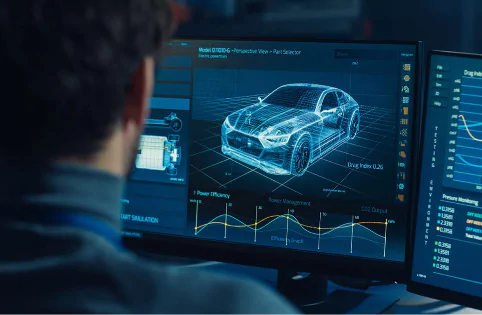What Is the Embedded Systems SDLC?

The embedded systems software development lifecycle must factor in the interface with system hardware.
The embedded systems software development lifecycle (SDLC), also known as the embedded software development process, refers to the systematic series of steps and activities involved in designing, developing, testing, deploying, and maintaining software that is embedded within a hardware system.
The typical software SDLC is meant to ensure that projects are well organized, manageable, and able to deliver high-quality software products. There are various SDLC models and methodologies, but the fundamental stages typically include planning and analysis of requirements, system design, implementation (coding), testing, deployment (release), maintenance and support, and evaluation and feedback.
The SDLC for embedded systems follows these stages, but because the software also interfaces with system hardware, some special considerations come into play. The embedded SDLC usually consists of the following stages:
- Requirements analysis and planning
- Requirements gathering: During extensive communication with stakeholders, including clients, developers, and end users, the team collects and documents the software requirements. These can be functional (what the software should do — its goals and objectives) and nonfunctional (performance, reliability, safety, etc.).
- Requirements specification: The gathered requirements are formalized into a detailed specification document, which serves as a reference for the development team.
- Project plan: This document outlines the scope, timelines, resources, and budget for the development effort.
- System design
- System architecture: High-level architectural decisions are based on the requirements and include defining the overall system’s structure, the roles of various software components, and how they interact.
- Detailed design: Once the system architecture is in place, the team creates detailed designs for individual software modules. These include data structures, algorithms, and interfaces.
- Implementation
- Coding: Software developers write the source code using a programming language suitable for the target hardware. Code should follow coding standards, be well documented, and include error-handling mechanisms.
- Testing
- Unit testing: This is the first level of testing (which can occur during the implementation phase), where individual functions or modules are tested in isolation to verify their correctness.
- Integration testing: Multiple software modules are combined and tested to ensure that they work seamlessly and that data flows correctly between them.
- System testing: The entire embedded system, including both hardware and software, is tested to verify that it meets the specified requirements and functions as intended.
- Verification and validation
- Verification: This process checks whether the software was built correctly according to the design and requirements. It ensures that the code is free of defects and adheres to coding standards.
- Validation: Here the focus is on whether the software meets the user’s needs and expectations. It involves testing the software in a real or simulated environment to ensure that it performs as intended.
- Integration
- Hardware and software integration: The embedded software is integrated with the hardware components of the system. The team thoroughly tests compatibility, data exchange, and communication protocols.
- Environmental testing: The system is tested under various environmental conditions to ensure that it operates reliably in different scenarios.
- Deployment (release)
- Loading and configuration: The software is loaded onto the target hardware platform, and the team applies any necessary configuration settings.
- Initial testing: After deployment, the system is tested in its target environment.
- Maintenance and updates
- Bug fixing: Any defects or issues discovered in the field are promptly addressed through bug fixes.
- Software updates: Periodically, updates may be released to add new features, improve performance, enhance security, or address vulnerabilities. These are often based on user feedback.
- Long-term support: Some embedded systems require long-term support to ensure continued reliability and compliance with evolving standards.
- Documentation
- Design documentation: Detailed design documents, architectural diagrams, and interface specifications are maintained to aid in future development and maintenance.
- User manuals: User-friendly operational documentation is provided to users.
- End-of-life (EOL)
- Product retirement: When an embedded system reaches the end of its lifecycle, plans are made for discontinuation. This may involve notifying users, offering replacements, and safely disposing of old hardware and software.
The level of detail and the specific processes within each stage can vary, depending on the complexity of the embedded system, the industry it serves, and the regulatory requirements it must meet. Common SDLC models include waterfall (sequential and linear), agile (iterative and incremental), Scrum (a specific agile framework), and DevOps (a system focusing on continuous integration and delivery).
Why Is the SDLC Critical for Embedded Software Success?

The SDLC helps teams communicate early on with each other and with project stakeholders.
Each SDLC phase is essential for ensuring that the software is developed efficiently, with high quality, and that it meets the needs of users and stakeholders. The SDLC provides structure and guidance, helping teams manage projects from concept to deployment and maintenance.
Embedded systems in particular are inherently complex, with intricate interactions between software and hardware components. The lifecycle offers a structured approach to managing this complexity, ensuring that requirements are meticulously defined, designs are carefully considered, and code is developed and tested systematically. Each stage targets particular aspects of product success. For example:
- Quality assurance: Because quality assurance is paramount in embedded systems, the lifecycle incorporates multiple stages of testing and validation to identify and rectify defects. This proactive approach mitigates risks, reduces the likelihood of critical errors making their way into the final product, and bolsters the overall reliability and safety of the system.
- Compliance: Many embedded systems operate in industries subject to specific standards and regulations. Automotive, aerospace, and healthcare are just a few examples. Adhering to a well-defined lifecycle is essential for compliance with these standards, and such compliance is often a legal requirement for market access.
- Maintenance and troubleshooting: Proper documentation throughout the lifecycle aids in knowledge transfer, facilitates upkeep, increases error detection, and supports future development efforts. As requirements evolve or issues emerge in the field, the structured lifecycle offers an efficient framework for managing changes, ensuring that modifications are documented and do not introduce new problems.
- Scalability: The described lifecycle promotes collaboration and scalability, making it suitable for larger projects involving multiple team members or development phases.
- Cost efficiency: The SDLC focus on early defect detection, efficient problem-solving, and reduced rework can lower both development and maintenance costs.
- Lifespan: Long-term support and adaptability, built into the lifecycle, contribute significantly to the success and longevity of embedded software projects.
Ultimately, a well-managed embedded software development lifecycle leads to customer satisfaction and ROI by ensuring that the final product meets or exceeds expectations for reliability, performance, and functionality.
How Can Wind River Help?

Wind River solutions can address every stage of the SDLC.
Wind River Edge
VxWorks
VxWorks® is the industry’s most trusted and widely deployed real-time operating system (RTOS) for mission-critical embedded systems that must be secure and safe. It delivers a proven, real-time, and deterministic runtime combined with a modern approach to development. Regardless of industry or device type, companies building intelligent edge systems rely on the VxWorks pedigree of security, safety, high performance, and reliability.
Wind River Linux
Wind River® Linux enables the development, deployment, and operation of robust, reliable, and secure embedded solutions running on a purpose-built Linux operating system. Without the risk and effort associated with roll-your-own (RYO) or unsupported silicon vendor Linux, Wind River Linux customizes the Linux OS for the specific requirements of your application. It includes an integrated artifact repository that is accessible to development and deployment teams alike, simplifying sharing and collaboration across the organization.
Wind River Linux has been the industry’s most advanced embedded Linux platform for more than 15 years. It offers a comprehensive suite of products, tools, and lifecycle services to build and support intelligent edge solutions.
» Learn More About Wind River Linux
Wind River Helix Virtualization Platform
Wind River Helix™ Virtualization Platform is a safety certifiable, multi-core, multi-OS platform that supports mixed levels of criticality. Leveraging the proven track record of successful, safety-certified, VxWorks RTOS technology, it consolidates multi-OS and mixed-criticality applications onto a single edge compute software platform, simplifying, securing, and future-proofing designs in the aerospace, defense, industrial, automotive, and medical markets.
Helix Platform combines a true Type 1 hypervisor with pre-integrated guest operating systems such as VxWorks and Wind River Linux. The platform is designed to support critical infrastructure development applications, including safety-certified applications found in avionics, automotive, and industrial markets. It is also designed for systems requiring the mixing of safety-certified applications with noncertified ones.
» Learn More About Helix Platform
Wind River Studio
Wind River Studio is a cloud-native toolset for developing, deploying, operating, and servicing mission-critical intelligent systems across the edge. Its host of tools and capabilities support teams with:
- Development in the cloud: Secure public, private, and hybrid clouds. Leverage the scalability, collaboration, and almost unlimited resources of cloud computing through our own distributed edge cloud (powered by Wind River Studio Cloud Platform), Microsoft Azure, or AWS.
- Collaborating in a CI/CD workflow: Connect all workflows through Studio Pipelines, a single pane of glass for agile, secure, and cyber-protected development and deployment for mission-critical applications and devices on the edge.
- Integrating applications: Infuse applications where, when, and how your teams need them in lifecycle management, from AI to cybersecurity to test and automation capabilities.
- Automating processes: Bring AI and machine learning into your development, security, deployment, and operations with the workflow automation and Digital Feedback Loop capabilities in Studio.
- Operating and servicing on the edge: Enterprises can manage updates and orchestrate fleets and 5G networks through a single pane of glass on the edge, and from the edge to core, for the new 5G economy.
- Lifespan: Long-term support and adaptability, built into the lifecycle, contribute significantly to the success and longevity of embedded software projects.
Wind River Simics
Wind River Simics® is a full-system simulator used by software developers to simulate the hardware of complex electronic systems.
Simics allows on-demand and easy access to any target system, more efficient collaboration between developers, and more efficient and stable automation. With Simics, you can adopt new development techniques that are simply not possible with physical hardware, enabling you to deliver better software faster.
Wind River Professional Services
Wind River is a global leader in delivering full lifecycle services for any design, across multiple market segments around the world. With nearly 40 years of deep industry experience, the award-winning Wind River Professional Services team has an unmatched track record of helping our customers build, deploy, and reimagine successful embedded software projects at every stage of the product lifecycle.
- Architecture and implementation services: Comprehensive solution services are delivered by an experienced team of experts who interpret system and market requirements, architect platform system options, and provide recommendations for meeting program goals throughout the life of your product.
- Security assessment: Start with a detailed written assessment of how to secure your embedded system, including your design, hardware options, operating system, and the software components.
» Learn More About Wind River Professional Services
» Learn More About Professional Services Security Assessment
Wind River Studio Linux Services
Benefit from ongoing CVE monitoring, mitigation, and management of your Yocto Project Linux platform through the software development and deployment lifecycle.
- Lifecycle security: Rely on ongoing monitoring, mitigation, and management of security issues throughout the lifecycle of your product, with services including license use identification, CVE mitigation, and SBOM and release documentation.
- Lifecycle performance assurance: Daily monitoring with emergency fixes for 10 or more years of your product lifecycle includes defect remediation, vulnerability remediation, and SBOM and release documentation.
» Learn More About Studio Linux Services Lifecycle Security
» Learn More About Studio Linux Services Lifecycle Performance Assurance